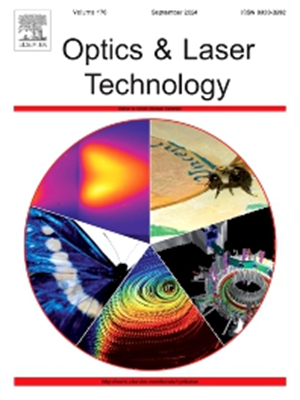Advancing VCSEL integration with femtosecond laser microstructuring and 3D nanoprinting
IF 5
2区 物理与天体物理
Q1 OPTICS
引用次数: 0
Abstract
With increasing demands on data processing speeds and the correspondingly high requirements for data transfer bandwidth, research is focusing on replacing pluggable optical transceivers with co-packaged optics architectures. Vertical-cavity surface-emitting lasers (VCSELs) have been considered a promising candidate in such configurations, but traditional optoelectronic packaging approaches—such as flip-chip and wire-bonding—fall short of meeting the low-cost and high-speed requirements. In this paper, we present the integration of bare-die VCSEL arrays into femtosecond laser-fabricated fused silica microwells, combined with direct on-VCSEL fabrication of micro-optics using two-photon polymerization-based direct laser writing. The VCSEL arrays, operating at a wavelength of 850 nm, are aligned in a face-up configuration and are electrically interconnected within a 5.5 µm passivation layer with photolithographically defined copper tracks. Efficient beam shaping is demonstrated by 3D nanoprinting 200 µm tall refractive and diffractive focusing microlenses directly onto the integrated VCSELs with an in-plane pitch of 250 µm. The emitted beams are focused into a 5 µm diameter Gaussian spot and are efficiently coupled into a single-mode fiber. This scalable packaging approach highlights the potential for compact, high-density solutions for co-packaged optics architectures with glass interposers.
推进VCSEL与飞秒激光微结构和3D纳米打印的集成
随着人们对数据处理速度的要求越来越高,对数据传输带宽的要求也越来越高,用共封装光模块架构取代可插拔光模块成为研究的重点。垂直腔面发射激光器(VCSELs)被认为是这种结构中很有前途的候选者,但传统的光电封装方法——如倒装芯片和线键合——无法满足低成本和高速的要求。在本文中,我们提出了将裸片VCSEL阵列集成到飞秒激光制造的熔融硅微孔中,并结合使用基于双光子聚合的直接激光写入直接在VCSEL上制造微光学。1×4 VCSEL阵列的工作波长为850 nm,以面朝上的方式排列,并在5.5 μ m的钝化层内与光刻定义的铜轨道电互连。通过3D纳米打印200微米高的折射和衍射聚焦微透镜直接到集成的vcsel上,其面内间距为250微米,证明了有效的光束整形。发射光束被聚焦成直径为5µm的高斯光斑,并有效地耦合到单模光纤中。这种可扩展的封装方法突出了具有玻璃中间层的共封装光学架构的紧凑、高密度解决方案的潜力。
本文章由计算机程序翻译,如有差异,请以英文原文为准。
求助全文
约1分钟内获得全文
求助全文
来源期刊
CiteScore
8.50
自引率
10.00%
发文量
1060
审稿时长
3.4 months
期刊介绍:
Optics & Laser Technology aims to provide a vehicle for the publication of a broad range of high quality research and review papers in those fields of scientific and engineering research appertaining to the development and application of the technology of optics and lasers. Papers describing original work in these areas are submitted to rigorous refereeing prior to acceptance for publication.
The scope of Optics & Laser Technology encompasses, but is not restricted to, the following areas:
•development in all types of lasers
•developments in optoelectronic devices and photonics
•developments in new photonics and optical concepts
•developments in conventional optics, optical instruments and components
•techniques of optical metrology, including interferometry and optical fibre sensors
•LIDAR and other non-contact optical measurement techniques, including optical methods in heat and fluid flow
•applications of lasers to materials processing, optical NDT display (including holography) and optical communication
•research and development in the field of laser safety including studies of hazards resulting from the applications of lasers (laser safety, hazards of laser fume)
•developments in optical computing and optical information processing
•developments in new optical materials
•developments in new optical characterization methods and techniques
•developments in quantum optics
•developments in light assisted micro and nanofabrication methods and techniques
•developments in nanophotonics and biophotonics
•developments in imaging processing and systems

 求助内容:
求助内容: 应助结果提醒方式:
应助结果提醒方式:


